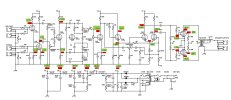Hi
out of passion for pink floyd, i built a hiwatt 50 myself, this is the first time ever my life to build an amp. the first running was good, no spark. and i plugged my guitar, it works fine. But i always feel like the sound is not satisfied, it's not like the sound i heard from the demo sound from kit-rae. Because people all say big muff with hiwatt sounds fabulous.( my big muff with hiwatt sounds way worse than the demo sound from kit rae ) i use the same amp and muff setting as him.
so i was questioning if its because of my incorrect building.
I measured all voltages. All the voltage measurements are under the situation:
Mains and standby on, all preamp and power tubes are installed, connected into 8ohms speaker. All the voltages are measured to the ground. All the heater voltages are 6.8v( all the tubes work fine)
I found 2 problems.
The first problem: for my ecc81 phase inverter tube,the readings are
Pin1 298v
Pin2 89v
Pin3 84v
Pin6 290v
Pin8 84v
Which are massively different from the theoretical reading according to the schematic
The second problem is the v3 ecc83
Pin1 320v
Pin2(grid)87v
Pin3 84v
Pin6 226v (when I tap it with multimeter, a huge blow sound appearing from the speaker)
Pin7(grid) 0v
Pin8 1.8v
Why there’s voltage on pin2(grid) and no voltage on pin7(grid). I think grid should not have voltage for preamp tubes except for the phase inverter tube(ecc81). Is this normal?
The schematic providing actual voltages is attached
I marked all the actual voltages in green and all the theoretical voltages on schematic.
Thanks for your help in advance
out of passion for pink floyd, i built a hiwatt 50 myself, this is the first time ever my life to build an amp. the first running was good, no spark. and i plugged my guitar, it works fine. But i always feel like the sound is not satisfied, it's not like the sound i heard from the demo sound from kit-rae. Because people all say big muff with hiwatt sounds fabulous.( my big muff with hiwatt sounds way worse than the demo sound from kit rae ) i use the same amp and muff setting as him.
so i was questioning if its because of my incorrect building.
I measured all voltages. All the voltage measurements are under the situation:
Mains and standby on, all preamp and power tubes are installed, connected into 8ohms speaker. All the voltages are measured to the ground. All the heater voltages are 6.8v( all the tubes work fine)
I found 2 problems.
The first problem: for my ecc81 phase inverter tube,the readings are
Pin1 298v
Pin2 89v
Pin3 84v
Pin6 290v
Pin8 84v
Which are massively different from the theoretical reading according to the schematic
The second problem is the v3 ecc83
Pin1 320v
Pin2(grid)87v
Pin3 84v
Pin6 226v (when I tap it with multimeter, a huge blow sound appearing from the speaker)
Pin7(grid) 0v
Pin8 1.8v
Why there’s voltage on pin2(grid) and no voltage on pin7(grid). I think grid should not have voltage for preamp tubes except for the phase inverter tube(ecc81). Is this normal?
The schematic providing actual voltages is attached
I marked all the actual voltages in green and all the theoretical voltages on schematic.
Thanks for your help in advance

